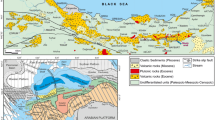Abstract
Our two newly obtained high-quality 40Ar/39Ar ages suggest that the high-K volcanic rocks of the Lawuxiang Formation in the Mangkang basin, Tibet were formed at 33.5 ± 0.2 Ma. The tracing of elemental and Pb-Sr-Nd isotopic geochemistry indicates that they were derived from an EM2 enriched mantle in continental subduction caused by transpression. Their evidently negative anomalies in HFSEs such as Nb and Ta make clear that there is an input of continental material into the mantle source. The high-K rocks at 33.5 ± 0.2 Ma in the Mangkang basin may temporally, spatially and compositionally compare with the early one of two-pulse high-K rocks in eastern Tibet distinguished by Wang J. H. et al., implying that they were formed in the same tectonic setting.
Similar content being viewed by others
References
Zhang, Y. Q., Xie, Y. W., Tu, G. C., Preliminary studies of the al-kali-rich intrusive rocks in the Ailaoshan-Jinshajiang belt and its bearing on rift tectonics, Acta Petrol. Sin. (in Chinese), 1987, (3): 17–25.
Pan, G. T., Wang, P. S., Xu, Y. R. et al., Cenozoic tectonic evolution of Qinghai-Xizang Plateau (in Chinese), Beijing: Geological Publishing House, 1990, 32–70.
Zhang, Y. Q., Xie, Y. W., Geochronology of Ailaoshan-Jinshajiang alkali-rich intrusive rocks and their Sr and Nd isotopic characteristics, Sci. China, Ser. D, 1997, 40(5): 522–528.
Deng, W. M., Huang, X., Zhong, D. L., Alkali-rich porphyry and its relation with intraplate deformation of the north part of the Jinsha River belt in western Yunnan, China, Sci. China, Ser. D, 1998, 41(3): 297–315.
Deng, W. M., Cenozoic Intraplate Volcanic Rocks in the Northern Qinghai-Xizang Plateau (in Chinese), Beijing: Geological Publishing House, 1998.
Deng, W. M., Sun, H. J., Zhang, Y. Q., K-Ar age of Cenozoic volcanic rocks in the Nangqen Basin, Qinghai Province and its geological significance, Chinese Sci. Bull., 2000, 45(11): 1014–1019.
Wang, J. H., Yin, A., Harrison, T. M. et al., A tectonic model for Cenozoic igneous activities in the eastern Indo-Asian collision zone, Earth Planet Sci. Lett., 2001, 188: 123–133.
Wang, J. H., Yin, A. Harrison, T. M. et al., Thermochronological constraints on two pulses of Cenozoic high-K magmatism in eastern Tibet, Sci. China, Ser. D, 2002, 32(7): 529–537.
Morley, C. K., A tectonic model for the Tertiary evolution of strike-slip faults and rifts basins in SE Asia, Tectonophysics, 2002, 347(4): 189–215.
Wang, E., Burchfiel, B. C., Late Cenozoic Xiangshuihe-Xiaojiang, Red River and Dali fault systems of southwestern Sichuan and central Yunnan, China, Geol. Soc. Am. Spec. Paper 327, GSA, 1998, 1-108.
The Bureau of Geology and Mineral Resources (Tibet), The Regional Geological Map of the Mangkang in Tibet (1?200,000) and Geological Report (in Chinese), Beijing: Geological Publishing House, 1991.
Lai, S. C., Mineral chemistry of Cenozoic volcanic rocks in Yumen, Hoh Xil and Mangkang lithodistricts, Qinghai-Tibet Plateau and its petrologigcal significance, J. NW. Univ. (Natural Sci. edition), 1995, 25(6): 701–704.
Lai, S. C., Features of megacrysts in Cenozoic volcanic rocks from Hoh Xil and Mangkang Lithodistricts, Qinghai-Tibet Plateau, Acta Mineral. Sin., 1999, 19(2): 236–244.
Harrison, T. M., Leloup, P. H., Ryerson, F. J. et al., Diachronous initiation of transtension along the Ailao Shan-Red River shear zone, Yunnan and Vietnam ((eds. Yin, A., Harrison, T. M.), The tectonic evolution of Asia, New York: Cambridge University Press, 1996: 208–226.
Liu, Y., Liu, H. C., Li, X. H., Simultaneous and precise determination of 40 trace elements in rocks samples using ICP-MS, Geochimica, 1996, 25(6): 552–558.
Rollinson, H. R., Using geochemical data: Evaluation, Presentation and Interpretation, London: Longman Group UK Ltd, 1993.
Schärer, U., Zhang, L. S., Tapponnier, P., Duration of strike-slip movements in the large shear zones: The Red River belt, China, Earth Planet Sci. Lett., 1994, 126: 379–397.
Chung, S. L., Lee, T. Y., Lo, C. H. et al., Intraplate extension prior to continental extrusion along the Ailao Shan-Red River shear zone, Geology, 1997, 25: 311–314.
Chung, S. L., Lo, C. H., Lee, T. Y. et al., Diachronous uplift of the Tibetan Plateau starting 40 Myr ago, Nature, 1998, 394: 769–773.
Lee, T. Y., Lo, C. H., Chung, S. L. et al., 40Ar/39Ar dating result of Neogene basalt in Vietnam and its tectonic implication ((eds. Flower, M. F. J., Chung, S. L., Lo, C. H.), Mantle dynamics and plate interactions in east Asia, Geodynamatics 27, AGU, Washington DC, 1998, 317–330.
Zhang, L. S., Schärer, U., Age and origin of magmatism along the Cenozoic Red River shear belt, Contrib. Mineral. Petrol., 1999, 134: 67–85.
Miller, C., Schuster, R., Klözli, U. et al., Post-collisional potassic and ultrapotassic activities in SW Tibet: Geochemical and Sr-Nd-Pb-O isotopic constraints for mantle source characteristics and petrogenesis, J. Petrol., 1999, 40: 1399–1424.
Turner, S., Arnaud, N., Liu, J. Q. et al., Post-collision, shoshonitic volcanism on the Tibetan Plateau: Implications for convective thinning of the lithosphere and the source of ocean island basalts, J. Petrol., 1996, 37: 45–71.
Xie, G. H., Liu, C. Q., Masuda, A. et al., The geochemical characteristics of Cenozoic volcanic rocks in the area of Qinghai-Tibet Plateau: Evidence for existing of an ancient enriched mantle, The Age and Geochemistry of Cenozoic Volcanic Rocks in China ((ed. Liu, R. X.) (in Chinese), Beijing: Seismological Press, 1992, 400–427.
Zhu, B. Q., Chen, Y. W., Chen, J. H., Lead isotope eochemistry of the urban environment in the Pearl River Delta, Applied Geochem., 2001, 16: 409–417.
Author information
Authors and Affiliations
Corresponding author
Rights and permissions
About this article
Cite this article
Zhang, H., He, H., Wang, J. et al. 40Ar/39Ar chronology and geochemistry of high-K volcanic rocks in the Mangkang basin, Tibet. Sci. China Ser. D-Earth Sci. 48, 1–12 (2005). https://doi.org/10.1360/03yd0125
Received:
Issue Date:
DOI: https://doi.org/10.1360/03yd0125




